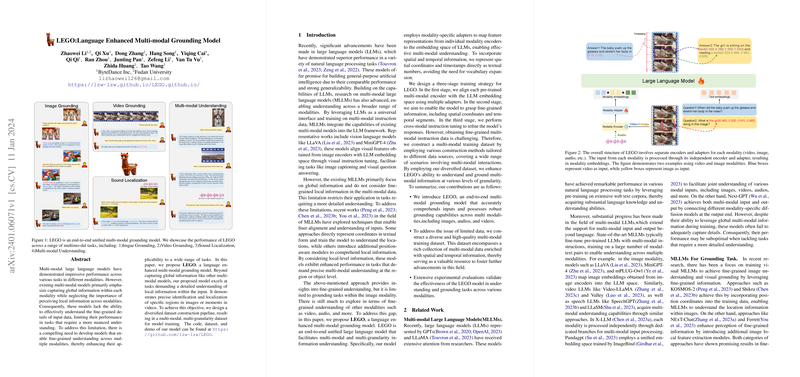Overview of GroundingGPT: Language Enhanced Multi-modal Grounding Model
The paper presents GroundingGPT, a model designed to enhance fine-grained grounding tasks across multiple modalities (image, video, and audio) by leveraging advancements in Multi-modal LLMs (MLLMs). Unlike existing MLLMs, which primarily focus on capturing global information, GroundingGPT is developed to address the gap in understanding local, fine-grained details essential for grounding tasks.
Model Architecture and Approach
GroundingGPT adopts an end-to-end architecture featuring modality-specific adapters that align features from image, video, and audio encoders with the embedding space of LLMs. The model's unique contribution lies in its fine-grained understanding capability, facilitated by a three-stage coarse-to-fine training strategy:
- Multi-modal Pre-training: This stage establishes the model's high-level semantic understanding using coarse-grained multimodal data.
- Fine-grained Alignment Tuning: The model then undergoes training to capture detailed information such as spatial coordinates within images and temporal sequences in videos. This stage addresses the scarcity of data through a specifically constructed multi-modal dataset that enhances the model’s grounding and understanding capabilities.
- Multi-granularity Instruction Tuning: Finally, nuanced instruction tuning is applied to refine the model's responses and improve its multi-modal interactions. This stage utilizes a diverse array of instruction-tuning datasets to ensure robust fine-grained understanding across different modalities.
Comparative Analysis and Results
GroundingGPT is compared against other MLLMs across multiple benchmarks:
- In image grounding tasks, such as the referring expression comprehension (REC) task on datasets like RefCOCO and RefCOCO+, GroundingGPT exhibits superior performance compared to models like Shikra and Ferret, both of which leverage additional modules for image perception.
- For video grounding, GroundingGPT significantly outperforms other baseline models on temporal grounding tasks, indicating its advanced temporal localization capabilities.
- Across a spectrum of visual question-answering and image understanding benchmarks, including VQA-v2 and TextVQA, GroundingGPT consistently achieves high metrics, demonstrating substantial improvements in interpreting complex visual scenarios.
- The paper also highlights GroundingGPT’s ability to mitigate object hallucination, presenting results on the POPE benchmark that underscore its effective integration of fine-grained information to reduce false positives in image descriptions.
Implications and Future Directions
The introduction of a unified approach to multi-modal grounding and understanding embodied by GroundingGPT has several important implications:
- Practical Applications: The enhanced grounding capability can be leveraged in areas requiring precise spatial or temporal understanding, such as autonomous systems, video surveillance, and human-computer interaction technologies.
- Theoretical Advancements: GroundingGPT highlights potential directions for further exploration in multi-modal research, particularly in balancing global and local data integration across varying input types.
- Further Research: Speculative avenues include refining the sampling strategy for video and audio inputs to minimize information loss and exploring additional cross-modal applications where multiple input modalities are processed simultaneously. Moreover, expanding grounding tasks to include outputs such as segmentation masks may add further utility.
Overall, this paper contributes significantly to the field by addressing critical limitations in existing MLLMs and offering a comprehensive solution that enhances multi-modal interaction capabilities, setting a benchmark for future explorations in AI-grounding tasks.
